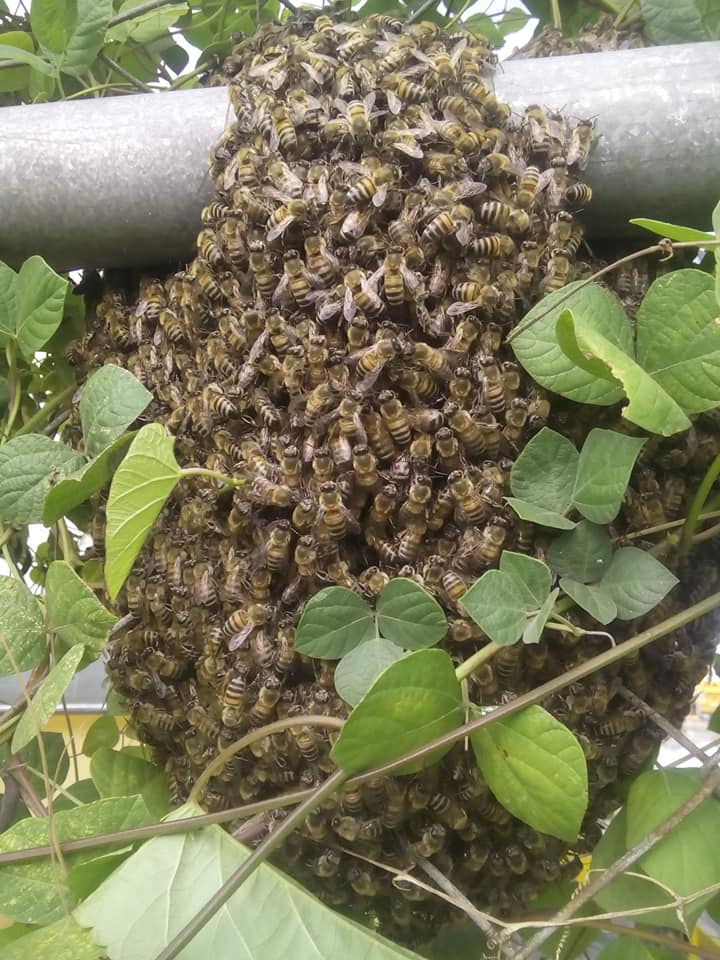In Guyana there are 50 different species of bees, however, the Africanised honey bees are the largest producer of honey in Guyana and are responsible for one third of the country’s food.
That’s according to Linden Stewart, the current Vice-Chairman of the Guyana Apiculture Society.
In recent weeks there have been several deadly attacks by Africanised honey bees in Guyana, particularly on the coastland.
Stewart, 59, can be described as a specialist in apiculture, that is the study and management of honey bees. He has been a beekeeper since he was 14-years-old.
The Society was formed in 2001 by a group of beekeepers and fosters collaboration, cooperation, training, and education in beekeeping. It is also actively involved in bee removals, captures, and relocation in Guyana.

During a recent interview with the News Room, Stewart explained that the Africanised honey bees are very territorial and defensive.
“Bees are only going to attack when they are disturbed. The hive will not leave and come and sting you like that, they feel threatened because the honey they store is for the bad weather,” Stewart explained.
During this time of the year, most of the trees are blossoming and this is when the bees will gather nectar to store in their hives for the bad weather.
Bees are deaf, but they sense vibrations and scents from as far as 50 feet from their hives.
These bees form their hives in old fridges, stoves, and drums that have been dumped and taken over with vegetation.
Stewart said that when the bees are relocating, it is not very far from their previous hive because the queen bee cannot fly a far distance.
“So persons may see a swarm of bees hanging on their gate and by the time they call the beekeeper, by the time we get there they take off because they stop to rest the queen,” Stewart said.
For the bees living in the wild, when persons go to clear lands- and there are several contractors clearing lands all over Guyana for housing and other developments- they are not aware that bees may be living in the area.
“Some persons clearing might be wearing a fragrance or might have had a drink of alcohol to drink the day before, the vibration from the weeding machine disturbs the bees, bees can be disturbed from by 50 feet or more from where they are living,” Stewart said.
Now when the bees sense the disturbance, a scout bee is sent out to investigate.
“They are going to be buzzing around somebody and all they are asking is to remove and we cannot communicate with their language.
“Now if you do not remove after the bee is buzzing around you it goes back to the hive (and) makes a display to show how far the predator is – they take you for a predator coming to take their queen and their honey,” Stewart explained.

He further explained that the scout bee will then release an alarm pheromone; this will let the other bees in the hive know who to attack.
“What we are asking the public to do to avoid these things is to pay attention to the vegetation area they are going to clear. Before you start clearing look and listen because you can hear the sound of buzzing bees, look for things flying in and out,” Stewart stressed.
Bees are not nuisances, Stewart said, as he compares bees with fire.
“They are good servants, but bad masters and we must be cautious when using matches and lighters and so we need to learn how to work with the bees.
“We have to learn to live with them, but at the said time we have to be cautious and we have to be careful,” Stewart stressed.

Chairman of the Apiculture Society, Neil Grant also stated that the Africanised honey bees can also reproduce quickly and are known to take over other docile bees and swarm very easily.
“We have even seen them in termites nest; they are very very adaptable,” Grant explained.
In Guyana, the Africanised honey bees form colonies; the queen bee lays 2000 to 3000 eggs per day and once the colony expands, it will not be able to feed all of the bees and as such, they begin to split and a colony would make about seven queens with each queen taking some bees and relocate.
The society is looking to collaborate with the Guyana Livestock Development Authority (GLDA) to conduct training in the various regions on how to safely remove bees from the wild and put them in safe places.
In the meantime, the Chairman said they are available and ready to go across the country to remove the bees.
If a person is allergic to bee venom they can die from one bee attack; for any other person, it takes about 500 stings. If anyone is stung by the Africanised honey bee they are encouraged to seek immediate medical attention.
The fourth recorded bee attack in Guyana in recent weeks has left a man identified, only as ‘Sunny’, dead and his friend hospitalised.
This latest reported fatal bee attack occurred on October 17 at Montrose Seawalls on the East Coast of Demerara.
John Sutherland, a 57-year-old labourer died after he was attacked by bees in Eversham Village, Corentyne in Region Six on October 07.
Dorothy Adams, a 58-year-old housewife from Ratter Dam East Bank Berbice, Region Six, also died on October 07 after she was attacked by a swarm of bees.
On October 08, 61-year-old Sirpaul ‘Rishi’ Hemraj, of Mibicuri South, Black Bush Polder also died after he and several others were attacked by bees.
Hemraj was a ranger and former Chairman of the Water Users Association. Hemraj and others had ventured into the backdam to check on an excavator when they were attacked by a swarm of bees.












